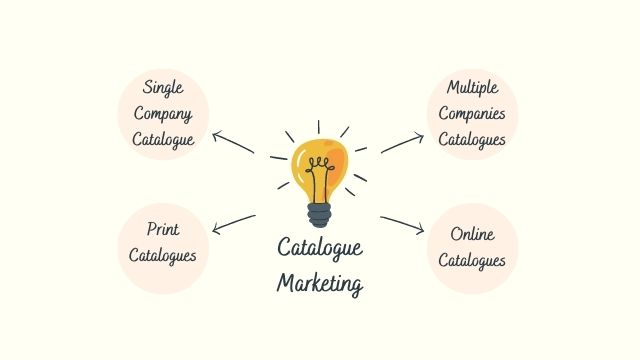Catalogue Marketing: Types of Catalogue Marketing

Catalogue marketing is a specialized type of direct marketing that continues to play an essential role in today’s marketing methods, such as social media and Internet advertising.
It may be easier for a single-product company to promote or market its product. In fact, even if a company sells two or three products, marketing will be easier because the think tank will have to concentrate on just one.
What if, on the other hand, a company sells a variety of distinct products? What if a store sells motorcycle spare parts? Is it feasible to promote each individual item separately?
To be honest, it would eat up a significant portion of your marketing budget. So, what are the options for such companies?
Although there are other choices, catalogue marketing is a widely used practice among these businesses. Have you ever heard of this term? Let’s try to figure out what it is.
What Is Catalogue Marketing?
Catalogue marketing, to put it simply, is a method of selling your items through catalogues. The business compiles a list of everything it sells and expects customers to select their chosen item(s) from the list. The list could be printed or digital (on an online platform).
How does It Work?
A company that uses catalogue marketing creates a catalogue and includes contact information such as an email address, phone number, or physical location.
The recipient of the catalogue then puts the order via one of the communication methods provided. Catalogue marketing is usually done in one of two ways:
- Sellers create their own catalogues and ask buyers to buy from them directly.
- Catalogue marketers serve as a link between manufacturers and consumers
A successful catalogue marketing campaign requires meticulous attention to detail, starting with comprehensive prepress consulting. Prepress services play a crucial role in ensuring the catalogue’s design is optimized for maximum impact. From layout to imagery selection, every element is carefully curated to entice potential buyers. Through strategic planning and collaboration, catalogue marketers streamline the process, bridging the gap between manufacturers and consumers seamlessly.
How Did Catalogue Marketing Gain Growth?
Catalogue marketing/sales can be traced back to the 17th century when Benjamin Franklin published a book catalogue in 1744. Later, in 1856, the Orvis Fishing catalogue was published, and it is still in print today (making it America’s oldest catalogue).
Due to shifting customer preferences, catalogue marketing has become a popular sales method. Consumers were more receptive to direct and catalogue marketing since it provided them with more options.
Besides that, catalogue marketing has grown in popularity in B2B markets as a more cost-effective alternative to personal sales calls.
Catalogue marketing is a type of direct marketing that allows businesses to target a certain demographic (targeted marketing). This allows firms to better target their potential clients and has a higher level of customer acceptance.
Read Also: What Is Marketing Channel? Why Marketing Channel Is Important?
Key Elements of Catalogue Marketing
The steps of the sales process are as follows:
- Distributing the catalogue to potential buyers (direct mailing, distribution or sale in stores, posting on the Internet, etc. ).
- Collecting and processing orders from customers (by mail, telephone, fax, Internet, etc. ).
- Completing orders and sending goods to customers (mail, courier, etc. ).
- Payment even by buyers of the goods (cash, checks, by means of credit cards or other forms of monetary tools).
Books, clothes and shoes, perfumes and cosmetics, jewelry, cultural, home, and commercial items, seeds and plants, and individual products (for example, baby food) are among the traditional categories of commodities for sale by catalogues. Catalogue sales have spread over numerous countries. This style is popular in the United States, England, and Germany, for example.
Types of Catalogue Marketing
There are four basic sorts of catalogue marketing, and here’s a quick rundown of each.

Single company catalogue
Catalogues from a single company are rather typical in businesses that produce a variety of products. In most cases, these types of businesses create their own catalogues.
Health items, sports products, apparel, footwear, jewelry, kitchen accessories, cosmetics, and other products are common examples of such companies or producers.
In general, vendors prepare their catalogues in a variety of ways, including:
Organizing comparable or related products: Let’s say a cosmetics company sells a variety of mascaras, nail paints, lipsticks, and other cosmetics. All sorts of mascaras will be grouped together under one name/head, but nail paints and lipsticks will be listed separately.
Alternatively, if any discounts are available, the company will update the catalogue accordingly. The vendor might potentially create a catalogue and list the things in a haphazard manner on various pages. This method can help you increase your impulse purchases.
Print Catalogues
In print catalogues, the seller usually creates a cover to announce the types of items or products in the catalogue, followed by a description of the items for sale. Product photographs, prices, and descriptions can all be found in these catalogues.
The merchant also indicates how to contact them or how to place an order. A single category with same types of products, such as footwear, apparel, and so on, may be featured in a print catalogue. It could also comprise a variety of product categories.
With print catalogues, some suppliers include order forms and return envelopes (with postage already paid). Aside from that, customers can place orders over the phone.
Because the print catalogue is an expensive sales tool, marketers employ tailored mailing lists to cut circulation and printing costs while increasing sales.
Although print catalogues may appear to be a dated marketing strategy, they have been resurgent in popularity since 2015.
Multiple Companies Catalogue
Catalogues from many firms, as the name implies, include products from multiple companies in the same catalogue.
This method of sales entails the use of middlemen and is particularly beneficial to enterprises with fewer items.
It assists many businesses in lowering their marketing costs while also reaping the benefits of catalogue marketing.
The catalogues are distributed to end users by retailers or intermediaries. Furthermore, clients prefer several company catalogues because they have more options (similar sort of products from different suppliers) to choose from.
When a buyer places an order, the purchasing process can go one of two ways:
- The mediator purchases the goods from the manufacturer and then sells it to the clients.
- The manufacturer sells straight to the consumers, while the intermediary earns a commission.
Online catalogues
Online catalogues look and function similarly to paper catalogues, except they are digital catalogues. Customers can access the catalogue using an internet portal used by the catalogue producer.
Online catalogues are the most recent addition to catalogue marketing, and they offer a number of benefits to both merchants and purchasers, including:
- For sellers, an online catalogue is a cost-effective choice (it saves the printing and mailing cost).
- On online catalogues, the merchant can readily change information.
- Buyers can purchase the required items right away.
The clearest illustration of online catalogue marketing is eCommerce. Various brands, such as Flipkart, Etsy, Amazon, and others, offer online catalogues.
Buyers can look at a variety of products before making an immediate purchase.

Advantages Of Catalogue Marketing
Catalogue marketing benefits firms and customers in a variety of ways.
- Customers are more accepting of catalogues, and they regard catalogues as a reliable source of information.
- Print catalogues are, in fact, easier to preserve for a longer amount of time (future purchases).
- For businesses, it is a cost-effective choice. For example, if a small firm can’t afford to establish its own catalogue marketing campaign, it might save money by using multiple companies’ catalogues. Aside from that, internet catalogues are a cost-effective choice.
- Catalogue marketing has a higher return on investment.
- Catalogue marketing has been demonstrated to convert 8 out of 10 buyers, according to studies.
- Catalogues allow you to meet clients at their homes rather than waiting for them to come to your store.
- They’ll know exactly what they want to buy this way.
- It is a more secure alternative in terms of funds.
- Customers are usually required to pay in advance when placing orders.
- This ensures that your funds are not stranded.
- Catalogue marketing allows a company to simply target a certain group of clients.
- Customers can examine products, their features, prices, specifications, and other information before making a decision.
Disadvantages Of Catalogue Marketing
- When it comes to growth, catalogue marketing might be a slow process. You must earn the trust of your clients, which takes time.
- To make a catalogue work, you’ll need outstanding copywriting abilities because persuading customers is difficult when there’s so much competition.
- Furthermore, a poorly designed catalogue can rapidly ruin your brand’s reputation.
- Customers that desire a tangible encounter before purchasing a product will not benefit from catalogue marketing.
Conclusion
Catalogues are unquestionably powerful marketing tools nowadays, even for those that want to be environmentally conscious.
There is no longer a competition between digital and print. It’s all about leveraging each medium’s strengths to build engagement that delights your customers (and boosts your financial line).
See how different industries are incorporating catalogue marketing into their current strategy, from beautifully handcrafted home additions to charities and education.

Q- Is catalogue marketing considered direct marketing?
A- Catalogue marketing is a type of direct marketing that focuses on catalogues. Many similarities exist between the two fields. Catalogue marketing is built on interactivity, or one-to-one engagement between the marketer and the prospect or consumer, similar to direct marketing.
Q- In the corporate world, what is a catalogue?
A- A catalogue is a book or magazine that contains information and images about things that are currently for sale, especially for companies who conduct a lot of business via mail order.
Q- What is an example of a catalogue?
A- A catalogue is a list of items, or a book or booklet containing a list of items. A catalogue, for example, is a list of all the books available at a library.
Q- What are cataloguing tools and how do you use them?
A- A cataloging department or technical services area at an academic library will find this collection of links and webpages valuable for all types of cataloging and classification resources.
Q- What exactly is a descriptive catalogue?
A- A library technique for identifying and describing a book or other item by documenting information such as author, title, imprint, and collation, as opposed to subject cataloging.






